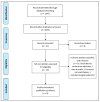Are Early Warning Scores Useful Predictors for Mortality and Morbidity in Hospitalised Acutely Unwell Older Patients? A Systematic Review
- PMID: 30274205
- PMCID: PMC6210896
- DOI: 10.3390/jcm7100309
Are Early Warning Scores Useful Predictors for Mortality and Morbidity in Hospitalised Acutely Unwell Older Patients? A Systematic Review
Abstract
Background: Early warning scores (EWSs) are used to identify deteriorating patients for appropriate interventions. We performed a systematic review to examine the usefulness of EWSs in predicting inpatient mortality and morbidity (transfer to higher-level care and length of hospital stay) in older people admitted to acute medical units with sepsis, acute cardiovascular events, or pneumonia.
Methods: A systematic review of published and unpublished databases was conducted. Cochrane's tool for assessing Risk of Bias in Non-Randomised Studies-of Interventions (ROBINS-I) was used to appraise the evidence. A narrative synthesis was performed due to substantial heterogeneity.
Results: Five studies (n = 12,057) were eligible from 1033 citations. There was an overall "moderate" risk of bias for all studies. The predictive ability of EWSs regarding mortality was reported in one study (n = 274), suggesting EWSs were better at predicting survival, (negative predictive value >90% for all scores). Three studies (n = 1819) demonstrated a significant association between increasing modified EWSs (MEWSs) and increased risk of mortality. Hazards ratios for a composite death/intensive care (ICU) admission with MEWSs ≥5 were significant in one study (p = 0.003). Two studies (n = 1421) demonstrated that a MEWS ≥6 was associated with 21 times higher probability of mortality (95% Confidence Interval (CI): 2.71⁻170.57) compared with a MEWS ≤1. A MEWS of ≥5 was associated with 22 times higher probability of mortality (95% CI: 10.45⁻49.16).
Conclusion: Increasing EWSs are strongly associated with mortality and ICU admission in older acutely unwell patients. Future research should be targeted at better understanding the usefulness of high and increasing EWSs for specific acute illnesses in older adults.
Keywords: EWS; critical care; geriatrics; morbidity; mortality; older people; vital signs.
Conflict of interest statement
No author declares a conflict of interest in relation to this study.
References
-
- Subbe C.P., Davies R.G., Williams E., Rutherford P., Gemmell L. Effect of introducing the modified early warning score on clinical outcomes, cardio-pulmonary arrests and intensive care utilisation in acute medical admissions. Anaesthesia. 2003;58:797–802. doi: 10.1046/j.1365-2044.2003.03258.x. - DOI - PubMed
-
- National Early Warning Score, National Clinical Guideline. NCEC; Dublin, Ireland: 2013. [(accessed on 1 February 2013)]. Available online: http://health.gov.ie/wp-content/uploads/2015/01/NEWSFull-ReportAugust201....
Publication types
LinkOut - more resources
Full Text Sources
Medical


